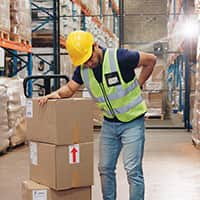Learn Lifting Techniques that Meet the OSHA Guidelines
Written by Staff Writer

Every year, more than 2.8 million workplace injuries cause employees to miss work. According to the U.S. Bureau of Labor Statistics (BLS), back injuries make up more than 38% of musculoskeletal disorders in the workplace.
The number of incidents is even higher in some occupations, such as:
- Laborers and warehouse workers
- Freight and material movers
- Stock and inventory management handlers
- Maintenance and repair workers
- Stock clerks and order fillers
- Nurses and nursing assistants
Regardless of your occupation, you should use proper lifting techniques that meet the OSHA guidelines to avoid injury. Once you hurt your back, muscles and ligaments can become scarred and weakened, leading to repeat problems and chronic pain.
We tend to think of on-the-job injuries in terms of a single incident. In fact, most health conditions that lead to disability claims result from repeated strains rather than a single incident. These incidents often occur over time at work and may not even be noticeable day-to-day.
Even for small tasks, improper lifting can lead to chronic problems over the years. Heavy objects can make health impacts even more severe.
Steps and Tips for Safe Lifting Techniques
The keys to workplace lifting safety are to minimize strain on the back and to use proper body mechanics. You can avoid common injuries in the workplace, such as strains and sprains, by:
- Sizing up the task: Assess whether the load is manageable for one person. If it appears too heavy or awkwardly shaped, ask for help.
- Keeping a wide base of support: Stand with your feet shoulder-width apart. This stance provides better balance and stability by spreading out the weight over a wider area.
- Squatting down, bending at the hips and knees: Squat down by bending at your hips and knees, not your waist. This positioning uses the strength of your legs rather than your spine.
- Keeping it close to your body: Keep the object as close to your trunk as possible. This reduces the strain on your spine and minimizes the force required to lift.
- Moving smoothly, keeping your back straight: When picking up items, use a steady, smooth motion. Avoid any twisting or jerking movements, which can lead to damage.
- Bending at the knees again: Finishing the lift is the same motion as picking up your cargo but in reverse.
Learn how to recognize hazards and when to ask for help. The easiest way to haul safely is using a machine. Avoid carrying heavy cargo by hand when equipment like dollies, pallet jacks, forklifts, hoists and cranes are available. Trust steel and wheels instead of muscle and bone.
Training Benefits
Besides creating a safer environment, training employees provides several key benefits.
One of the biggest is lowering absenteeism by reducing time off requests. This can also reduce your healthcare costs. And it can help reduce your workers' compensation premiums and other medical expenses.
Creating a safety culture across your organization pays in other ways, too. Improve employee morale and productivity while cutting down on turnover — a common challenge for jobs that involve physical work.
You can also lower your liability by complying with OSHA workplace regulations. Failure to comply can lead to fines, which can cost more than $16,000 per violation. Repeated or willful violations can lead to fines 10 times higher —some of which may accumulate every day until the problem is remedied.
Effective Education
Employers have an obligation to provide a safe and healthy workplace. The Occupational Safety and Health Administration states that training is an important part of the ergonomic process to ensure workers stay safe and understand the hazards of work-related musculoskeletal disorders (WMSDs).
OSHA Education Center offers several high-quality online educational programs that meet OSHA standards for workforce training.
Warehouse Safety Certificate Course
Learn warehouse regulations and safety procedures. That includes best practices for approaching and carrying all kinds of loads. You will learn how to safely handle, transport and store materials in a warehouse, including identifying hazards.
Office Safety Online Course
Office workers need protection, too. This course helps you identify common office hazards, adjust workspace ergonomics and make your workspace safe for you and your coworkers.
Industrial Ergonomics Certificate Course
Industrial jobs can be quite physical, creating stress and strain on the body. This education program covers industrial settings, demonstrates when you are most vulnerable to stress injuries and teaches how posture and ergonomic design can prevent them.
Hand, Wrist and Finger Safety Certificate Course
This online program teaches best practices to prevent hand and wrist damage, including choosing the personal protective equipment (PPE) you need to stay safe.
Crane Safety in Industrial and Construction Environments
This interactive education program focuses on the potential dangers of working with cranes, including rigging, moving and landing cargo. Learners will understand OSHA regulations designed to provide a safe environment.
Benefits of Choosing OSHA Education Center
We make your safety training easy. All our classes are available 100% online. You get 24/7 access anywhere from any device with internet access. Log in, study and log off whenever you like. Once you finish, you can download and print your Certificate of Completion immediately!
OSHA Education Center courses are designed by industry experts to help employers and employees alike meet the training obligations outlined in OSHA Standards 29 C.F.R. 1926.21(B)(2). Quality education can protect you, your coworkers and your employees from on-the-job safety incidents.
Sign up today! Pick one of the courses mentioned above or explore our large course catalog with more than 150 safety programs to find the one that's right for you.
